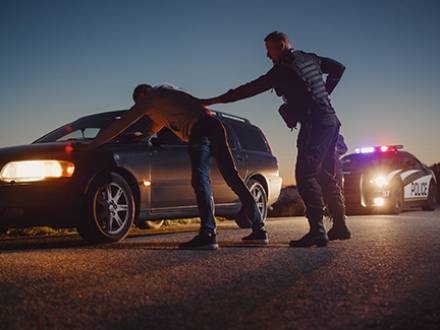FOURTH AMENDMENT FRIDAY FUNDAMENTALS - CASE #4: Rodriguez v. US
 It’s the 4th Fourth Amendment Friday Fundamentals and time, I believe, for a quick synopsis of the cases covered so far.
It’s the 4th Fourth Amendment Friday Fundamentals and time, I believe, for a quick synopsis of the cases covered so far.
I started with Delaware v. Prouse, a case which significantly curtailed the ability of the police to conduct random traffic stops, requiring reasonable and articulable suspicion of criminal or illegal activity to be present for the stop to be Fourth Amendment compliant.
But how to determine reasonable suspicion, asked the lower courts. The Supremes answered with US v. Cortez, a case out of Arizona which established a totality of the circumstances approach to reviewing whether sufficient reasonable suspicion was present to justify the traffic stop. The Court emphasized that the totality of circumstances included a review of the "whole picture."
Last week, I covered Navarette v. California, a case involving anonymous 911 calls and traffic stops, including a brief history of the courts prior anonymous tip jurisprudence. In a divided decision, the Supremes found, inter alia, mere use of the 911 phone system provided indicia of reliability, and a report of a single of instance of driving deviation to be sufficient for a traffic stop.
This week’s Fourth Amendment Friday Fundamentals case is Rodriguez v. US, 575 U.S. 348 (2015), a decision written by the late Justice Ginsberg. While it is a dog sniff case, I am, as I suspect many of you would be, much more interested in the idea of an illegal prolonged detention. But before I get into that, let’s look at the Court’s pre-Rodriguez jurisprudence:
We’ll start with two cases from 1983. First, U.S. v. Place, 462 U.S. 696 (1983), where DEA agents seized luggage in an airport based on suspicion of drug trafficking, and subjected it to a dog sniff without a warrant. The Court held that the dog sniff is not a search under the Fourth Amendment, but suppressed the evidence anyway because the detention took too long (90 minutes). From this case we get the idea that while the sniffs aren’t searches, the detention has to be reasonable in length in order to be Fourth Amendment compliant.
Then we have Florida v. Royer, 460 U.S. 491 (1983), another DEA airport seizure, this time of a passenger fitting a drug courier profile. The Court held that a detention was unlawful if it exceeded the scope of a Terry stop and the detention here was more akin an arrest absent probable cause. From this case we get the idea that there is also a limit on the scope of a detention.
Two years later, the Supremes again take up the timing of detention in US v. Sharpe, 470 U.S. 675 (1985), where police stop two vehicles they suspect are related to drug trafficking, and one suspect was detained for 20 minutes until backup arrived. The Court there held that there was no rigid time limit for a detention; the reasonableness depended on whether the police were diligently pursuing the investigation.
Two decades later, someone let the dogs out in Illinois v. Caballes, 543 U.S. 405 (2005), and during a routine speeding ticket traffic stop, a dog is used by one officer while the other writes a ticket. The Court held no Fourth Amendment violation when the detention does not prolong the traffic stop. Again, we see the key limitation is the timing.
Now, I know that there are other dog sniff cases (Florida v. Harris and Florida v. Jardines, both from 2013 for example), but since we are looking at Rodriguez more as a detention case than a dog sniff case, I will leave those two for another day.
In a case out of Nebraska, Rodriguez was pulled over for a minor traffic deviation, driving briefly onto the shoulder of the road. The officer requested and obtained the necessary documents from the driver, ran a records check, returned to the vehicle to get the documents from the passenger, ran a records check on him, and returned to the vehicle a third time to issue a warning. The officer then returned all of the documents obtained from both occupants of the vehicle.
The officer later testified that at this point in the investigation, he had "taken case of all the business" for the stop, but did not consider Rodriguez free to leave. Instead he asked for permission to walk his dog around Rodriguez’s vehicle. The dog, of course, alerted. The meth, of course, was found. Rodriguez, of course, was indicted, and moved to suppress based on an illegal detention. The motion was denied, and denial was affirmed by the Eighth Circuit, finding the seven- or eight-minute delay in the case a de minimus intrusion.
A seizure remains lawful, wrote the Court, provided that the length of the detention lasts no longer than necessary to complete the purpose of the stop. While prior cases, including Caballes, held that the Fourth Amendment was not violated when unrelated investigations (including dog sniffs) did not lengthen the roadside detention, the Court emphasized here that a stop can become unlawful if prolonged beyond the time necessary to complete the stated purpose of the stop without sufficient reasonable suspicion of criminal activity. Since the officer had diligently pursued the purpose of the traffic stop, issuing the warning ticket, and had complete the stop, returning the documents, any ongoing detention was unjustified.
In other words, a traffic stop cannot be extended in duration or in scope beyond the initial purpose without independent reasonable suspicion of criminal activity.





